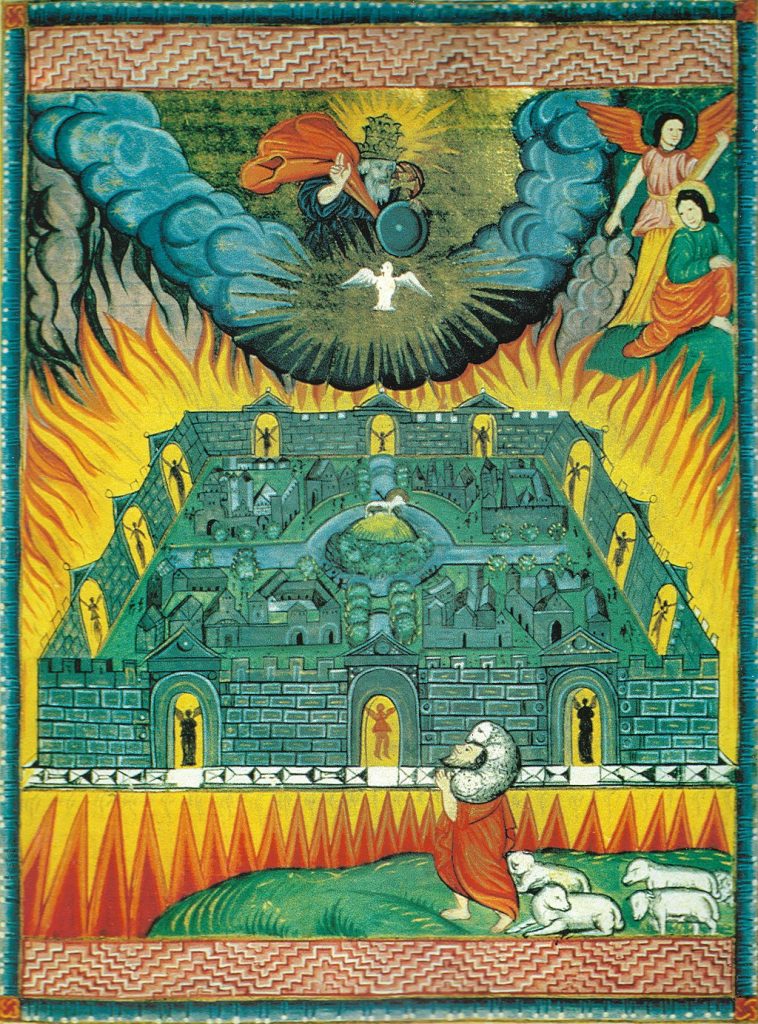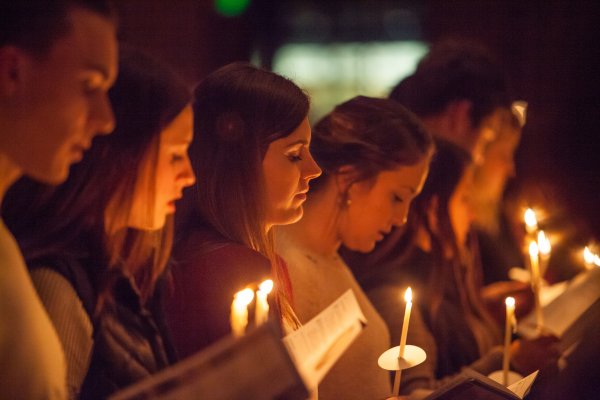Imagining Eternity

This little painting was made in 1645 by Malnazar and Aghap’ir, a pair of Armenian illuminators living in the Armenian community of New Julfa, a suburb of the Persian (Iranian) city of Isfahan, then the capital of the Persian empire. Illuminators create illuminations, the small illustrations and visual embellishments that are a feature of handmade medieval books, in this case, a Bible. This little painting, for all its detail, measures under 8 x 10 inches.
The image is that of the New Jerusalem coming down from heaven, as described in the vision given to John the Apostle and recorded in the Book of Revelation. We can see several of the features described by John. The whole city glows with a radiance of a jewel and, because it is descending from heaven, it doesn’t quite touch the ground.
There are twelve gates facing each of the four directions and each guarded by an angel. The lamb who is Jesus sits enthroned in the center of the city. The river of life which is described as flowing from the throne flows in all four directions from that center but stops at the city gates. The tree of life is impossibly described by John as growing on both sides of the river and this little painting solves that problem by presenting the tree of life as several trees, each with a spherical top, growing along all four branches of the river. God the Father presides over the whole display with a raised right hand, an indication that God is speaking. The Holy Spirit is also present in the form of a dove. The angel that has been directing John’s attention is present in the upper right hand corner, holding the golden measuring rod with which to measure the city and so demonstrate its perfection. John sees it all from his place at the bottom of the image. Ever the pastor, he’s accompanied by sheep.
Some describe Armenian art from this period as naive or primitive. To give some context, the great painters of the Italian renaissance, like Michelangelo and DaVinci, noted for their attention to anatomy and light, were working a century before Malnazar and Aghap’ir produced this image. Next to the ceiling of the Sistine Chapel, or the Mona Lisa, this painting of the New Jerusalem looks almost like a cartoon. I think that this is its genius.
We can tell right away that this is not a realistic depiction of any known geography. There is nothing photographic about this fanciful image. As such it conforms to John’s text which uses everyday words to describe things which defy description: How does a city descend to earth? How does a lamb provide light like a lamp? What kind of tree grows on both sides of a river?
The description of the New Jerusalem is a reminder that for us, who are bounded by time and space, eternity defies human knowledge and description because we have no first-hand experience.
This past Monday was All Saints Day, a day set aside for giving thanks for the eternal inheritance given to those who had died in the past year. As part of our commemoration, photos of Valpo faculty and staff who have died this past year are on display around the baptismal font in the Chapel’s main space. During this Sunday morning’s prayers, all the names of those who have died in the past year and are known to us will be read aloud. We have their images and their names. Some of us have stories and memories of our time with these who are now among the blessed dead. We have no access, however, to their experience of eternity. For that we lean on the promise of peace with God and a resurrection that was pioneered by Jesus Christ. To that we can add descriptions and illustrations, like this little Armenian painting, that we know will necessarily fall away when we ourselves see God face to face.
Peace be with you,
Pr. Jim
Nov. 3, 2021
Pastor Jim and Pastor Kate take turns writing weekly devotions for the Chapel of the Resurrection. Contact them here:
Image: Armenian Patriarchate of Jerusalem, Public domain, via Wikimedia Commons
For more on Armenian art and culture and to learn how it is that Armenians came to live in Iran, see:
Dickran Kouymjian Armenian Art: An Overview
Julfa in Encyclopedia Iranica Online
- Archives of Devotional Writings from our Pastoral Staff
- “HELP!”
- “Some Lent!”
- (Your vocation here) of people
- A call to courage for 2021
- A charming tale for over-achievers
- A Lesson On Beans … and Being
- A New Place
- A Point of Privilege
- A season of anticipation
- A Time of Dust
- Acquiring a peaceful spirit
- Advent = Hope
- All will be well
- Anastasis: the Greatest Story of God’s Saving Power
- Another kind of darkness
- Are we willing to cross the road for one another?
- As if we needed a reminder
- Beacons of hope
- Better Together
- Blessings As You Go
- Borderlands
- Can we learn to be happy?
- Carrying the COVID Cross
- Come and See
- Did Jesus really suffer?
- Doing without in a life of plenty
- Don’t miss this moment
- Exiles with Vision
- Fear not!
- Fear of the Lord
- Feeling at Home
- Finding Purpose in the Journey
- Finding Words for Times Like These
- Forgiving others – and ourselves
- Getting ahead with Jesus
- Getting down on Jesus’ level
- Getting through this together
- God is not overwhelmed
- Good Friday
- Grief & Graduation
- Have yourself a merry little Christmas — somehow
- Holy Week and Taking Out the Trash
- Holy Week: The aid station late in the semester
- Hopes & Dreams vs Life in the Wilderness
- How do you keep from giving up hope?
- How glad we’ll be if it’s so
- I almost slipped
- Imagining Eternity
- In a time of uncertainty, these things are certain
- In everything, grateful
- In praise of plans B … C … D …
- In the midst of grief, God will bring life
- Is there such a thing as being too forgiving?
- It’s a Three Day Weekend!
- It’s In the Bag
- It’s What’s Happening
- Jesus among us
- Killing off our future selves
- Knowing a Good Thing When We See It
- Lessons in fire building
- Let there be light!
- Let us work for real wellness in our communities
- Life Is a Highway
- Lilies and leaves and whatever else is beautiful
- Living in the Present
- Naming our demons
- O Lord, you know I hate buttermilk
- Of Fear and Failure
- On Christian Unity: When we’re not one big happy church
- On the Bucket List
- On the day after the night before
- Overwhelmed
- Persistent and Extravagant
- Pray and Let God Worry
- Praying for Reconciliation
- Preparing for the world to be turned rightside up
- Recovering from an Epic Fail
- Reformation calls for examination
- Remembering among the forgetful
- Rest
- Rest is Holy
- Right where we are
- Seeing beauty in brokenness
- Signs of Love
- Starting Small
- Still in the storm
- Surprisingly Simple: Breathe!
- Taking a Break from the Relentless
- Talking ourselves into it
- Thankfulness leads to joyfulness
- The Art of Holy Week
- The Funny Business of Forgiveness
- The Greatest of These is Love
- The Magi: Exemplars of Faith and Learning
- The Power of Small Conversations
- The Trouble with Mammon
- The Power of Taking a Sabbath
- The Spiritual Gift of Hindsight
- This can’t be done alone
- To be known
- Too.Much.
- You might be a Lutheran if…
- You will be in our prayers this summer of 2020
- Ventures of which we cannot see the ending
- WWJD? We already know
- Walking in the Light of Jesus’ Resurrection
- We had hoped
- We’re on a mission from God
- What do you do with your anger?
- What good is a shepherd?
- What is your base reality?
- What to do after you find your voice
- What to do on the day after
- What we know and what we don’t know
- When bad things happen
- When God uses something terrible for good
- When heaven & earth click
- When joy and sadness live together
- When stress overwhelms
- When the promise of resurrection is hard to believe
- When you offer up your broken cup
- When we are moved
- Where God will be found
- Where is the good shepherd carrying you?
- Wilderness Journeys
- Won’t you be my neighbor?
- Year-end time management: Keeping the main thing the main thing
- Your Valpo roots will help you grow into your future
